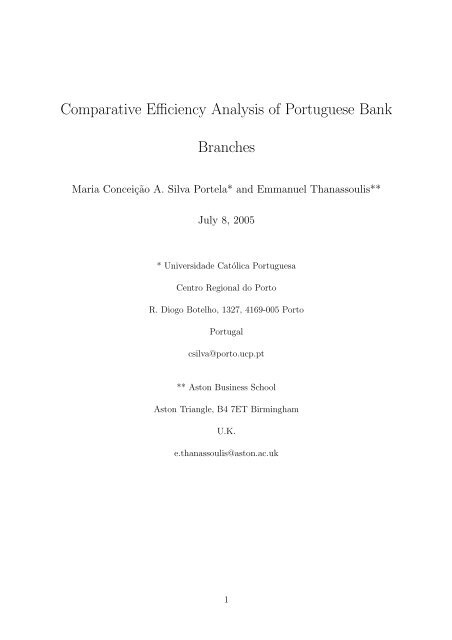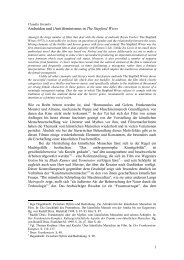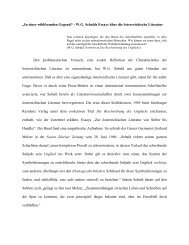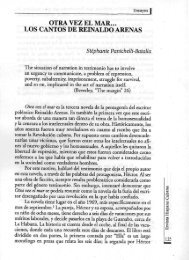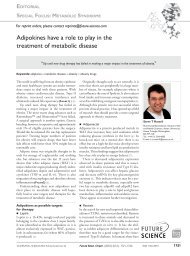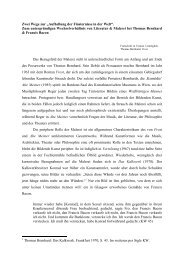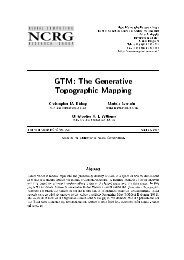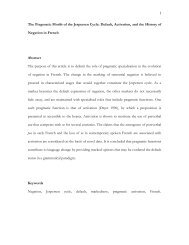Comparative Efficiency Analysis of Portuguese Bank Branches
Comparative Efficiency Analysis of Portuguese Bank Branches
Comparative Efficiency Analysis of Portuguese Bank Branches
You also want an ePaper? Increase the reach of your titles
YUMPU automatically turns print PDFs into web optimized ePapers that Google loves.
<strong>Comparative</strong> <strong>Efficiency</strong> <strong>Analysis</strong> <strong>of</strong> <strong>Portuguese</strong> <strong>Bank</strong><br />
<strong>Branches</strong><br />
Maria Conceição A. Silva Portela* and Emmanuel Thanassoulis**<br />
July 8, 2005<br />
* Universidade Católica Portuguesa<br />
Centro Regional do Porto<br />
R. Diogo Botelho, 1327, 4169-005 Porto<br />
Portugal<br />
csilva@porto.ucp.pt<br />
** Aston Business School<br />
Aston Triangle, B4 7ET Birmingham<br />
U.K.<br />
e.thanassoulis@aston.ac.uk<br />
1
Abstract<br />
The advent <strong>of</strong> Internet banking and phone banking is changing the role <strong>of</strong> bank branches<br />
from a predominantly transaction-based one to a sales-oriented role. This paper reports on<br />
an assessment <strong>of</strong> the branches <strong>of</strong> a <strong>Portuguese</strong> bank in terms <strong>of</strong> their performance in their<br />
new roles in three different areas: Their efficiency in fostering the use <strong>of</strong> new transaction<br />
channels, their efficiency in increasing sales and their customer base, and their efficiency<br />
in generating pr<strong>of</strong>its. Service quality is also a major issue in service organisations like<br />
bank branches, and therefore we analyse the way this dimension <strong>of</strong> performance has been<br />
accounted for in the literature and take it into account in our empirical application. We<br />
have used Data Envelopment <strong>Analysis</strong> (DEA) for the different performance assessments,<br />
but we depart from traditional DEA models in some cases. Performance comparisons on<br />
each dimension allowed us to identify benchmark bank branches and also problematic bank<br />
branches. In addition, we found positive links between operational and pr<strong>of</strong>it efficiency and<br />
also between transactional and operational efficiency. Service quality is positively related<br />
with operational and pr<strong>of</strong>it efficiency.<br />
Keywords: <strong>Bank</strong>ing, <strong>Efficiency</strong>, Service quality, Pr<strong>of</strong>itability<br />
2
1 Introduction<br />
The emergence <strong>of</strong> new forms <strong>of</strong> banking presents a challenge to the predominance <strong>of</strong> bank<br />
branches as the main avenue <strong>of</strong> providing financial services. These alternative ways <strong>of</strong> bank-<br />
ing include, phone banking, internet banking and automatic banking (through automatic<br />
teller machines - ATMs). The increasing use <strong>of</strong> alternative banking channels (ECB, 1999a)<br />
is clearly changing the traditional way <strong>of</strong> understanding and undertaking banking activities.<br />
At the bank branch level the emergence <strong>of</strong> new distribution channels might only partly<br />
be able to reduce the importance <strong>of</strong> bank branches as distribution means <strong>of</strong> financial ser-<br />
vices, especially due to the increase in personal-advice intensive banking activities that is<br />
being undertaken (ECB, 1999b). <strong>Bank</strong> branches have been shifting from operating services<br />
to consulting (ECB, 1999b), i.e., they are placing less importance on the delivery <strong>of</strong> transac-<br />
tional services and more importance on exploiting the potential <strong>of</strong> branch networks as selling<br />
outlets for financial services (e.g. Drake and Howcr<strong>of</strong>t, 1995; Howcr<strong>of</strong>t and Beckett, 1993;<br />
Howcr<strong>of</strong>t, 1992). In this sense, new distribution channels can be regarded as advantageous to<br />
bank branches, since they can place more emphasis on value-added activities (sales related)<br />
leaving basic transactions to be performed on other means <strong>of</strong> distribution. For the bank as<br />
a whole this represents a cost advantage, since general operations performed on alternative<br />
means <strong>of</strong> distribution are cheaper than when performed by bank branches’ personnel.<br />
Existing studies on bank branches efficiency do not in general account for the changing<br />
role <strong>of</strong> bank branches. Most <strong>of</strong> these studies analyse efficiency <strong>of</strong> bank branches from a<br />
production perspective 1 (in contrast with a intermediation perspective (see e.g. Colwell and<br />
Davis, 1992)), where bank branches are seen as production units using a set <strong>of</strong> resources<br />
1 See e.g. Sherman and Gold (1985); Parkan (1987); Vassiloglou and Giokas (1990); Giokas (1991); Tulkens<br />
(1993); Drake and Howcr<strong>of</strong>t (1994); Sherman and Ladino (1995); Athanassopoulos (1997); Schaffnit et al.<br />
(1997); Camanho and Dyson (1999); Zenios et al. (1999); Soteriou and Zenios (1999); Golany and Storbeck<br />
(1999); Avkiran (1999); Athanassopoulos et al. (2000); Athanassopoulos and Giokas (2000); Hartman et al.<br />
(2001).<br />
3
(mostly staff, space, computers and supply costs) to produce a number <strong>of</strong> services (mostly<br />
measured through the number <strong>of</strong> transactions at a bank branch and/or the number <strong>of</strong><br />
various accounts). Albeit important, a production perspective fails to reflect other important<br />
dimensions <strong>of</strong> bank branches. In order to try to circumvent this problem some authors have<br />
used together various perspectives <strong>of</strong> bank branches activities (see e.g. Athanassopoulos<br />
(1997), Athanassopoulos et al. (2000), Berger et al. (1997), etc.). Most <strong>of</strong> these studies do<br />
not account, however, for the new role <strong>of</strong> bank branches toward selling nor link this new<br />
role with the growth <strong>of</strong> alternative/competitive ways <strong>of</strong> providing banking services like the<br />
internet, phone banking and ATMs. In addition, the role <strong>of</strong> sales as the most important<br />
operational output <strong>of</strong> bank branches has not been acknowledged in older studies, but only<br />
recently by Cook et al. (2000) and Cook and Hababou (2001), who take explicitly into<br />
account the new role <strong>of</strong> bank branches by distinguishing two types <strong>of</strong> activities that happen<br />
in bank branches: transactions (or service) and sales.<br />
The purpose <strong>of</strong> the present study is to specify suitable efficiency measures that take<br />
into account sales activities <strong>of</strong> bank branches, and transactional activities that should be<br />
performed on alternative distribution channels. Apart from these two dimensions <strong>of</strong> bank<br />
branches activities we also consider their pr<strong>of</strong>it. <strong>Bank</strong> branches are for-pr<strong>of</strong>it organisations<br />
and therefore an analysis <strong>of</strong> their performance should also account for this dimension. The<br />
use <strong>of</strong> pr<strong>of</strong>it efficiency measures may also be seen as a way <strong>of</strong> incorporating a service quality<br />
dimension into the analysis, since accounting both for costs and revenues may avoid classify-<br />
ing a higher quality bank or bank branch as cost inefficient just because it produced higher<br />
quality (and therefore generated more revenues) at the expense <strong>of</strong> higher costs (Berger et al.,<br />
1993). Service quality is <strong>of</strong> utmost importance in analysing the performance <strong>of</strong> bank bran-<br />
ches, since their survival depends on the service quality levels they provide. We consider<br />
this performance dimension a posteriori for reasons that will be outlined afterwards.<br />
4
The paper is structured as follows. In the next section a set <strong>of</strong> efficiency measures that<br />
we developed to analyse the overall performance <strong>of</strong> bank branches is put forth. In section 3<br />
these measures are applied to a sample <strong>of</strong> <strong>Portuguese</strong> bank branches and results are cross-<br />
compared. In section 4 our results are compared with prior views <strong>of</strong> managers <strong>of</strong> the bank<br />
under analysis, and section 5 concludes this paper.<br />
2 Measuring the Performance <strong>of</strong> <strong>Bank</strong> <strong>Branches</strong><br />
Many managers believe that the growing use <strong>of</strong> new distribution channels does not constitute<br />
a threat to the survival <strong>of</strong> bank branches, at least not in the short run. This fact is, in-<br />
stead, taken as an opportunity to move non-value-added transactions to these new channels,<br />
leaving branches with more time to devote to value-added activities. Seeing new means <strong>of</strong><br />
distribution as an opportunity for increasing pr<strong>of</strong>its, the bank under analysis charged their<br />
branches with the responsibility for motivating customers to use alternative channels. As a<br />
consequence, the main objectives that bank managers ask their branches to pursue are:<br />
• To foster an effective use <strong>of</strong> new distribution channels so that branch personnel can<br />
use their time in value-added activities;<br />
• To increase sales and the customer base <strong>of</strong> the branch, while serving the clients that<br />
visit the branch with high service quality levels;<br />
• To manage the product mix in a way that generates high pr<strong>of</strong>itability, without reducing<br />
service quality associated with any product.<br />
Given these objectives it is important to develop corresponding performance measures to<br />
assess the extent to which each <strong>of</strong> these objectives is being achieved by bank branches. For<br />
this purpose, we developed three performance measures: transactional, operational, and<br />
5
pr<strong>of</strong>it, corresponding to each <strong>of</strong> the objectives stated above. The assessment <strong>of</strong> performance<br />
on the three dimensions is centered at the bank branch and therefore we used DEA to<br />
compare bank branches on each dimension (for details on this methodology see e.g. Cooper<br />
et al. (2000) and Thanassoulis (2001)). Note that as banking activities are increasingly<br />
performed through a mix <strong>of</strong> distribution channels it is difficult to credit a particular channel<br />
for a particular sale (in general more than one channel is involved in each sale). The bank<br />
branch is, however, for the <strong>Portuguese</strong> market still the preferred distribution channel and<br />
therefore it makes sense to focus our analysis on this channel. We opted to use DEA in this<br />
analysis primarily for two reasons: Firstly, as will be seen below, the assessments involve<br />
setting multiple inputs against multiple outputs and DEA is one <strong>of</strong> the assessment methods<br />
that can most easily handle such contexts. Secondly, we avoid the need to make prior<br />
assumptions as to the functional form linking inputs and outputs as would be needed if we use<br />
a parametric distance function approach. There is the difficulty that DEA cannot account<br />
for random noise in the data but this is less important when we are looking for general<br />
indications rather than definitive numerical measures <strong>of</strong> performance <strong>of</strong> bank branches.<br />
For measuring operational and pr<strong>of</strong>it efficiency some methodological developments were<br />
needed, and therefore we developed our own models to measure these efficiencies. In the<br />
next sections we define each efficiency measure and point out the main issues that were<br />
raised in their development. We do not make an exhaustive presentation <strong>of</strong> mathematical<br />
models since the aim <strong>of</strong> this paper is to present empirical results rather than to dwell on<br />
methodological issues (for details the reader is referred to Portela (2003)).<br />
2.1 Transactional <strong>Efficiency</strong><br />
Transactional efficiency is defined as the extent to which a bank branch moves general<br />
transactions away from the branch to alternative means <strong>of</strong> distribution. Note that our<br />
6
interest here is not related to the efficiency <strong>of</strong> new distribution channels as a selling outlet<br />
for the bank as a whole (DEA would not probably be the right tool for performing such an<br />
analysis). Our focus is on the role <strong>of</strong> bank branches - our unit <strong>of</strong> analysis - in motivating<br />
their customers to use new distribution channels.<br />
The input-output variables used in this assessment are shown in Table 1. These variables<br />
are available monthly for the period from January 2002 to September 2002. The chosen<br />
Table 1: Inputs and Outputs used to assess transactional efficiency in month t<br />
Inputs Outputs<br />
1. Number ETMs (ATMs + CATs) (t) 1. N. New registrations for internet use (t)<br />
2. Rent (t) 2. N. Transactions in CATs (t)<br />
3. N. Clients not registered (t-1) 3.N. Deposits in ETMs (t)<br />
variables differ from those we considered ideal, since the bank could not supply some data<br />
(like transactions on each distribution channel made by a branch’s own clients, or socio-<br />
economic characteristics <strong>of</strong> clients that affect their propensity to use new channels). On<br />
the input side <strong>of</strong> the transactional efficiency assessment we try to account for the resources<br />
that allow a bank branch to foster the use <strong>of</strong> alternative distribution channels. The number<br />
<strong>of</strong> ETM’s is the sum <strong>of</strong> automatic teller machines (ATM’s) and cheque dispenser machines<br />
(CAT’s). The variable ‘rent’ is a surrogate for the location and size <strong>of</strong> the bank branch (this<br />
variable is used internally by the bank and does not depend on the bank owning the branch<br />
or not), and the variable ‘number <strong>of</strong> clients not registered’ links with the output ‘number <strong>of</strong><br />
registrations for internet use’ (which basically measures each month how many customers<br />
registered that month to use internet). The other outputs used in the transactional efficiency<br />
assessment are intended to capture the degree <strong>of</strong> usage <strong>of</strong> ETMs. As we were interested in the<br />
usage <strong>of</strong> this distribution channel by branch’s clients we considered only those transactions<br />
whose probability <strong>of</strong> being done by a branch client is higher. This is the case <strong>of</strong> deposits in<br />
ETM’s, and all transactions in CAT’s. The number <strong>of</strong> ETMs at a branch and the notional<br />
7
ent for the branch jointly capture not only the size <strong>of</strong> the client base <strong>of</strong> the branch but also<br />
their quality so that in general the higher the levels <strong>of</strong> rent and ETMs the larger the levels<br />
management would expect, all else being equal, on outputs 2 and 3 in Table 1.<br />
Note that in the transactional efficiency assessment we focus on branches’ clients only,<br />
and therefore neglect the effort <strong>of</strong> branches’ personnel in motivating clients that are not<br />
their own in using alternative distribution channels. This is a necessary simplification for<br />
performing the analysis at the branch level. This clearly represents a limitation <strong>of</strong> the<br />
assessment, as some branches located in high passing trade zones may have more transactions<br />
performed by non-branch clients than by their own clients. This fact may under-estimate<br />
the efforts <strong>of</strong> a branch in motivating customers (irrespective <strong>of</strong> the branch in which they are<br />
clients) to use alternative distribution channels.<br />
Note that we have not included manpower as part <strong>of</strong> the input set in Table 1 in order to<br />
capture any inefficiency in the use <strong>of</strong> new channels attributable to the branch having deployed<br />
an inappropriate staff complement. Otherwise a branch could set a low staff complement<br />
against low usages <strong>of</strong> new channels and still appear efficient. Yet there may have been<br />
potential to raise further the use <strong>of</strong> new channels if more staff had been hired.<br />
The DEA model used to measure transactional efficiency each month was a variable<br />
returns to scale (VRS) output oriented model (<strong>Bank</strong>er et al., 1984). We used VRS because<br />
it is a less restrictive assumption than CRS. We have no a priori reason to believe that for<br />
efficient branches outputs and inputs are proportional. This was supported by statistical<br />
tests (see e.g. <strong>Bank</strong>er, 1996) that showed CRS and VRS efficiencies cannot be assumed to<br />
come from the same distribution.<br />
8
2.2 Operational <strong>Efficiency</strong><br />
Operational efficiency is related to all types <strong>of</strong> operations that go on in a bank branch. It<br />
accounts especially for value-added operations (sales related) and therefore this measure is<br />
linked with the previously defined transactional efficiency. That is, the more transactions a<br />
bank branch moves to alternative distribution channels the more time branch staff will have<br />
to perform value-added activities, and therefore it is likely that the operational efficiency is<br />
higher for those bank branches showing higher transactional efficiency.<br />
The operational efficiency assessment considers data from March 2001 to September<br />
2002. The input-output set used in this assessment is shown in Table 2, where (t) denotes<br />
time period and the Greek ∆ denotes change in values between the start and the end <strong>of</strong><br />
period t.<br />
Table 2: Inputs and Outputs used to assess operational efficiency in month t<br />
Inputs Outputs<br />
1. Number Staff (t) 1. ∆ Number <strong>of</strong> Clients (t)<br />
2. Rent (t) 2. ∆ Value Current Accounts (t)<br />
3. ∆ Value Other Resources (t)<br />
4. ∆ Value Titles Deposited (t)<br />
5. ∆ Value Credit by <strong>Bank</strong> (t)<br />
6. ∆ Value Credit by Associates (t)<br />
7. Number Transactions (t)<br />
The inputs we have used reflect the main operational resource <strong>of</strong> bank branches (staff) 2<br />
and its environmental conditions (rent). Note that we present in Table 2 a reduced set<br />
<strong>of</strong> variables because <strong>of</strong> data limitations. Had suitable data been available we would have<br />
liked to also consider in the operational efficiency assessment inputs relating to the market<br />
potential the branch is in since this is a factor potentially affecting its ability to increase<br />
customers and the value <strong>of</strong> the various products it sells.<br />
2 The argument stated before for not including personnel in the transactional efficiency assessment does<br />
not apply in Table 2 where staff are an input, because here we want to capture the efficiency <strong>of</strong> staff deployed<br />
in performing transactions and sales while in Table 1 we want to capture the efficiency <strong>of</strong> the branch in<br />
converting the potential for clients to switch to new channels.<br />
9
The outputs in Table 2 are intended to reflect the main operational objectives <strong>of</strong> bank<br />
branches; (i) to increase the customer base (reflected in the output ∆ number <strong>of</strong> clients),<br />
(ii) to increase sales <strong>of</strong> the various products the branch has to <strong>of</strong>fer (reflected in outputs<br />
2 to 6 3 ), and (iii) to serve clients (reflected in the output number <strong>of</strong> general transactions).<br />
As the bank could not supply us with sales values we used a surrogate for sales given by<br />
the difference between values in month t and t − 1. This resulted in some outputs being<br />
negative. In order to apply DEA to negative data we developed a model called Range<br />
Directional Model (RDM) (see Portela et al., 2004) that is based on the directional distance<br />
model <strong>of</strong> Chambers et al. (1996, 1998). The model used was output oriented but the output<br />
‘number <strong>of</strong> transactions’ was considered non-discretionary 4 , i.e., an output that the bank<br />
branch does not want to improve. This is consistent with the new role <strong>of</strong> bank branches<br />
that focus especially on selling and prefer general transactions to be performed on alternative<br />
distribution channels. The RDM output model is presented in appendix A.<br />
Note that the specification <strong>of</strong> outputs as the difference between values in period t and<br />
values in period t−1, results in a DEA model that is equivalent to another where we consider<br />
the absolute value in t − 1 on the input side and the absolute value in t on the output side,<br />
with the additional constraint that the weights attributed to pairs <strong>of</strong> inputs and outputs,<br />
related in this way, should be equal. More details on this point can be found in Portela<br />
(2003).<br />
3 Some <strong>of</strong> these outputs deserve some explanations. Other resources include term deposit accounts,<br />
emigrant accounts, investment funds, savings insurance, etc. We consider here two broad classes <strong>of</strong> credit<br />
(as classified by the bank): credit by the bank includes consumer’s credit, cards credit, overdrafts, etc.; and<br />
credit by associates includes factoring and leasing, which is provided by associate companies inside the same<br />
financial group.<br />
4 The non-discretionary <strong>of</strong> transactions was treated in the RDM model according to the approach <strong>of</strong><br />
<strong>Bank</strong>er and Morey (1986).<br />
10
2.3 Pr<strong>of</strong>it <strong>Efficiency</strong><br />
The pr<strong>of</strong>it efficiency measure is intended to capture the extent to which a bank branch is<br />
pr<strong>of</strong>it maximising. Note that our interest here is not simply to calculate what the pr<strong>of</strong>it<br />
(understood as an accounting concept) was, but to compare the potential for pr<strong>of</strong>it maximi-<br />
sation <strong>of</strong> bank branches.<br />
The pr<strong>of</strong>it efficiency assessment uses data from March 2001 to September 2002. The<br />
input-output variables used in this assessment are shown in Table 3. These variables are<br />
Table 3: Inputs and Outputs used to assess pr<strong>of</strong>it efficiency in month t<br />
Inputs Outputs<br />
1. Number <strong>of</strong> Staff (t) 1. Value Current Accounts (t)<br />
2. Supply costs (t) 2. Value Other Resources (t)<br />
3. Value Credit Over <strong>Bank</strong> (t)<br />
4. Value Credit Associates (t)<br />
consistent with the intermediation approach <strong>of</strong> bank branches’ activities as discussed before<br />
(for details see Portela and Thanassoulis, 2005). Note that an important output that is not<br />
included in our analysis is non-interest revenue. This is an increasingly important output<br />
since competitive pressures on bank pr<strong>of</strong>its have led bank branches to create other sources<br />
<strong>of</strong> revenues through commissions and fees. Unfortunately the bank was not able to supply<br />
this output and therefore we could not use it in our analysis.<br />
Apart from the ‘quantity’ variables specified in Table 3, price data were also available for<br />
staff (average salaries) and for all outputs. We used the variables in Table 3 to compute two<br />
types <strong>of</strong> efficiency: technical and overall pr<strong>of</strong>it efficiency. For the technical pr<strong>of</strong>it efficiency<br />
measurement we used the variables as specified in Table 3. For calculating overall pr<strong>of</strong>it<br />
efficiency we used the ‘quantity’ data specified in Table 3 plus price information. Note that<br />
output prices used were net interest rates, meaning that when outputs were multiplied by<br />
prices the result was net interest revenue (interest revenue - interest cost) rather than simply<br />
11
interest revenue.<br />
The results we report in this paper concerning pr<strong>of</strong>it efficiency do not consider factor<br />
prices. That is, we report on values <strong>of</strong> technical pr<strong>of</strong>it efficiency and not overall pr<strong>of</strong>it<br />
efficiency. The reader is referred to Portela and Thanassoulis (2005) for details on the<br />
assessment <strong>of</strong> overall pr<strong>of</strong>it efficiency and its decomposition into technical and allocative<br />
efficiency. The technical pr<strong>of</strong>it efficiency assessment undertaken was based on non-oriented<br />
DEA models where at the same time outputs could increase and inputs could decrease 5 .<br />
The model used was based on a geometric distance function (GDF) detailed in Portela and<br />
Thanassoulis (2005). In Appendix B we show the basic models within the GDF procedure<br />
including the model used in this paper to calculate technical pr<strong>of</strong>it efficiency.<br />
3 Main Results<br />
Monthly efficiency results (including efficiency scores, target levels and peers) were produced<br />
for each performance dimension for a total <strong>of</strong> 57 bank branches. This type <strong>of</strong> information is<br />
too detailed to be presented in this paper, where our aim is to show general results on each<br />
performance dimension and the links between them. In addition, for the bank as a whole<br />
more important than having monthly detailed efficiency results for each branch, it is to<br />
know those bank branches that showed a consistently efficient or inefficient behaviour over<br />
the period <strong>of</strong> analysis, and to have an overall picture <strong>of</strong> the performance <strong>of</strong> bank branches in<br />
each dimension. In the sub-sections that follow we compare pairwise results from the three<br />
efficiency assessments. For this purpose we calculated, for each branch, average efficiency<br />
scores (transactional, operational or pr<strong>of</strong>it) for the overall period <strong>of</strong> analysis (this is January<br />
5 This orientation was chosen so that the resulting measure reflected pr<strong>of</strong>it efficiency. Otherwise, if an<br />
input orientation was chosen the resulting measure would reflect cost efficiency and if an output orientation<br />
was chosen the resulting measure would reflect revenue efficiency.<br />
12
2002 to September 2002 for transactional efficiency, and March 2001 to September 2002 for<br />
the operational and pr<strong>of</strong>it assessments).<br />
3.1 Operational <strong>Efficiency</strong> Vs Pr<strong>of</strong>it <strong>Efficiency</strong><br />
Average efficiency scores obtained from the operational and pr<strong>of</strong>it efficiency assessments are<br />
plotted in Figure 1 6 . We choose in this Figure a threshold <strong>of</strong> 90% for good efficiency and<br />
Figure 1: Pr<strong>of</strong>it <strong>Efficiency</strong> and Operational <strong>Efficiency</strong><br />
consider that below this value branches have scope to improve performance. This threshold is<br />
arbitrary since the managerial implications <strong>of</strong> drawing such a graph do not really depend on<br />
the chosen threshold, but on the number <strong>of</strong> units close to the ideal performance (1, 1). Note<br />
that different threshold may be justified by different magnitudes <strong>of</strong> efficiency/inefficiency.<br />
6 These averages are computed based on independent efficiency assessments made each month. In the<br />
whole study from where the results in this paper are extracted (Portela, 2003), an analysis <strong>of</strong> not only<br />
efficiency change but also technological change (i.e. changes in the technological frontier) was performed.<br />
We do not detail on this type <strong>of</strong> results in this paper for sake <strong>of</strong> brevity.<br />
13
<strong>Bank</strong> <strong>Branches</strong> with good performance both in pr<strong>of</strong>it and operational terms can be<br />
classified as ‘stars’ (Bouss<strong>of</strong>iane et al., 1991) and they represent benchmarks to be emulated<br />
by inefficient branches. Problematic branches are those that have low operational and low<br />
pr<strong>of</strong>it technical efficiency. Special attention should be paid to these branches and action is<br />
needed to diagnose their problems and to improve their performance.<br />
<strong>Bank</strong> branches with good pr<strong>of</strong>it efficiency and low operational efficiency do not exist in<br />
our data set (see Figure 1). The absence <strong>of</strong> bank branches in this quadrant is in line with<br />
common sense, since branches with low operating efficiency (i.e. showing a poor performance<br />
in selling and attracting new customers) are not likely to be efficient in generating pr<strong>of</strong>its.<br />
Our results therefore are not surprising.<br />
The correlation coefficient between average pr<strong>of</strong>it and average operational efficiency is<br />
0.3. This is not a very high correlation coefficient but it is statistically significant at the 5%<br />
level. This means that, in a limited way, higher operational efficiency tends to be related<br />
with higher pr<strong>of</strong>it efficiency as can be seen in Figure 1.<br />
A more detailed analysis <strong>of</strong> star branches and problematic branches in Figure 1 can be<br />
undertaken by analysing differences in their input/output levels. In the radar graphs shown<br />
in Figure 2 we can compare the operational and pr<strong>of</strong>it efficiency average input/output levels<br />
<strong>of</strong> star branches with those <strong>of</strong> low operational and low pr<strong>of</strong>it branches (LOLP). In the radar<br />
Figure 2: Star Vs LOLP branches<br />
14
graph on the left we can see that LOLP branches use on average about the same staff and<br />
supply costs as star branches to produce much less <strong>of</strong> all the outputs considered in the pr<strong>of</strong>it<br />
assessment. Differences are even more marked for the case <strong>of</strong> the inputs and outputs used<br />
to measure operational efficiency (radar graph on the right). Note that in the above radar<br />
graphs values for each variable are normalised by the values observed for star branches.<br />
The analysis <strong>of</strong> radar graphs such as those shown in Figure 2 provides useful managerial<br />
information to bank managers since they can easily identify where improvement should be<br />
sought with priority. For example, when the operational objective <strong>of</strong> growth is considered,<br />
we can see that LOLP branches should focus on improving growth <strong>of</strong> current accounts,<br />
other resources and credit associates. In terms <strong>of</strong> titles deposited and clients growth these<br />
branches perform on average similarly to star branches and therefore these areas do not give<br />
particular cause for concern. By achieving growth in the critical areas LOLP bank branches<br />
will achieve higher volumes <strong>of</strong> credit and other resources that will contribute also to improve<br />
their performance in the pr<strong>of</strong>it efficiency assessment.<br />
3.2 Operational <strong>Efficiency</strong> Vs Transactional <strong>Efficiency</strong><br />
Comparing pr<strong>of</strong>it and operational efficiency with transactional efficiency shows a positive and<br />
statistically significant correlation between transactional efficiency and operational efficiency,<br />
but a non-significant correlation between pr<strong>of</strong>it and transactional efficiency. In Figure 3 we<br />
show the matrix that cross compares operational and transactional efficiency. The values in<br />
this figure are average efficiency scores from January 2002 to September 2002.<br />
In the same way as before we can see some bank branches in the star quadrant showing<br />
high operational and high transactional efficiency. In particular, branches B4 and B54 have<br />
100% efficiency in both dimensions and this makes them suitable role models for emulation<br />
by other branches. There are virtually no branches in the low operational-high transactional<br />
15
Figure 3: Transactional <strong>Efficiency</strong> and Operational <strong>Efficiency</strong><br />
quadrant in Figure 3, meaning that branches that are good performers in moving transac-<br />
tions to other means <strong>of</strong> distribution are, in general, also good performers in operational<br />
activities that are not transactions related. Indeed the correlation coefficient between these<br />
two performance dimensions is 0.46 and this value is statistically significant at the 1% level<br />
even if relatively low. This fact confirms our initial hypothesis that moving transactions to<br />
alternative means <strong>of</strong> distribution gives branch staff more time to dedicate to value added<br />
activities that leads to increasing sales and the customer base <strong>of</strong> the bank branch (which<br />
are outputs <strong>of</strong> the operational efficiency assessment).<br />
3.3 Link between <strong>Efficiency</strong> and Service Quality<br />
Service quality is an important aspect to be accounted for in an efficiency analysis <strong>of</strong> service<br />
organisations like bank branches. For this type <strong>of</strong> organisations we can distinguish between<br />
two concepts <strong>of</strong> efficiency: internal efficiency, related to the efficiency by which outputs<br />
16
can be produced through a given amount <strong>of</strong> inputs, and external efficiency, related to the<br />
efficiency by which perceived service quality is produced through a given amount <strong>of</strong> inputs<br />
(Grönroos, 2000). While in manufacturing organisations it may be easier to separate internal<br />
and external efficiency, in service organisations these two measures <strong>of</strong> efficiency are entangled.<br />
That is, the introduction <strong>of</strong> more “cost effective production resources and processes does<br />
not necessarily lead to better economic results” (Grönroos, 2000, p. 206). This is because<br />
internal efficiency is related to cost efficiency (cost savings can be achieved by improving<br />
internal efficiency) but external efficiency is related to revenue efficiency (low service quality<br />
may result in a loss <strong>of</strong> customers and revenues) (see also Howcr<strong>of</strong>t, 1991; Thanassoulis et al.,<br />
1995). A way to account for both internal and external efficiency is through a pr<strong>of</strong>it analysis<br />
since the former is related to costs and the latter to revenues (see also Berger et al. (1993),<br />
who argue that pr<strong>of</strong>it efficiency can account for differences in quality between banks) 7 .<br />
Service quality has been considered in some DEA bank branches studies either through<br />
the inclusion <strong>of</strong> quality variables into the efficiency analysis (Parkan, 1987; Golany and<br />
Storbeck, 1999; Athanassopoulos, 2000), or by post-hoc analysis where a service quality<br />
index is compared to efficiency measure(s) (Schaffnit et al., 1997; Athanassopoulos, 1997).<br />
In this study we adopt this latter perspective, though we consider that service quality is<br />
intrinsical to efficiency assessments <strong>of</strong> service organisations even if no direct service quality<br />
variables are present in the assessment model, provided other variables in the model capture<br />
the impact <strong>of</strong> service quality. This is so in our case where variables such as change in client<br />
or asset base (in the operational efficiency assessment) and value <strong>of</strong> various assets (in the<br />
pr<strong>of</strong>it efficiency assessment) do capture the impact <strong>of</strong> service quality. The levels <strong>of</strong> these<br />
7 Note that pr<strong>of</strong>it as defined in accounting terms may be considered a second best tool to measure the<br />
firm’s long term performance, given the lagging effect between changes in quality and the corresponding<br />
changes in pr<strong>of</strong>it. This lagging effect makes a static analysis <strong>of</strong> pr<strong>of</strong>it efficiency <strong>of</strong> reduced importance and<br />
suggests this efficiency should be measured over time so that quality differences may be captured. In our<br />
empirical application we use a 18 month period and so our analysis considers pr<strong>of</strong>it over an extended period<br />
allowing many lagging effects to be captured.<br />
17
variables would drop if service quality is poor.<br />
In our empirical study the service quality variable we have is an index based on monthly<br />
questionnaires sent to branch customers. In Figure 4 we show the scatter plot <strong>of</strong> operational<br />
efficiency and service quality. The data on service quality relates to September 2002, meaning<br />
that it is an average <strong>of</strong> SQ indexes from September 2001 to September 2002. The average<br />
values calculated for operational and pr<strong>of</strong>it efficiency measures also consider this year period.<br />
Note that the threshold that we consider for the service quality index is 0.8, because it seemed<br />
Figure 4: Operational <strong>Efficiency</strong> Vs Service Quality<br />
reasonable to assume that a bank branch with a service quality level above this value was<br />
performing at high levels <strong>of</strong> service quality.<br />
Figure 4 shows a positive relationship between operational efficiency and the service<br />
quality index. The correlation coefficient is 0.43 and this is significant at the 1% level. More<br />
important than analysing this relationship is, however, the analysis <strong>of</strong> the bank branches<br />
that lie on each <strong>of</strong> the quadrants identified in Figure 4. It is interesting to note that there<br />
are virtually no branches in the quadrant with low operational efficiency and high service<br />
18
quality, which obviously is in accordance with the common sense feeling that bank branches<br />
providing high service quality are more effective in increasing their customer base and in<br />
selling banking products. Star branches in Figure 4 can be seen as benchmarks in operational<br />
terms, since they show at the same time high operational efficiency and high service quality.<br />
Such branches attain growth rates that are better than those <strong>of</strong> other branches, while at the<br />
same time they tend to serve clients with a better service quality than other bank branches.<br />
Comparing service quality with pr<strong>of</strong>it efficiency reveals the picture shown in Figure 5.<br />
Here the relationship between service quality and pr<strong>of</strong>it efficiency is not as clear as with<br />
Figure 5: Pr<strong>of</strong>it <strong>Efficiency</strong> Vs Service Quality<br />
operational efficiency. We can now find some branches in the quadrant with low pr<strong>of</strong>it<br />
efficiency and high service quality. Nevertheless, there appears to be a positive relationship<br />
between pr<strong>of</strong>it efficiency and service quality, meaning that higher service bank branches tend<br />
to be good performers both in terms <strong>of</strong> generating pr<strong>of</strong>its and in terms <strong>of</strong> operational growth.<br />
In fact the correlation coefficient between service quality and pr<strong>of</strong>it efficiency is lower than<br />
before (0.371) but this value is still significant at the 1% level. The weaker relationship<br />
19
etween pr<strong>of</strong>it efficiency and service quality may be due to the lag effect between the costs<br />
<strong>of</strong> quality and the revenues accruing from superior quality that we mentioned before.<br />
The relationship between service quality and transactional efficiency is completely dif-<br />
ferent from those shown before, as there appears to be no relationship between these two<br />
performance dimensions. This can be seen in Figure 6.<br />
Figure 6: Transactional <strong>Efficiency</strong> Vs Service Quality<br />
The correlation coefficient between transactional efficiency and service quality is -0.0914<br />
and this value is not statistically significant. This fact seems to suggest that the efficiency by<br />
which bank branches move transactions away from the bank branch does not affect service<br />
quality. This is an important finding since it means that customers do not associate the<br />
increasing use <strong>of</strong> alternative distribution channels (and the decreasing use <strong>of</strong> the branch for<br />
transactional purposes) with losses in terms <strong>of</strong> service quality (nor gains).<br />
In order to better understand the implications <strong>of</strong> cross-comparing the various perfor-<br />
mance dimensions, we looked at some bank branches and analysed their performance in<br />
each dimension. In Figure 7 we show the performance <strong>of</strong> three bank branches in terms <strong>of</strong><br />
pr<strong>of</strong>it efficiency, operational efficiency, transactional efficiency, and service quality (average<br />
values from January 2002 to September 2002). In this Figure it is clear that branches B54,<br />
B40 and B17 have different pr<strong>of</strong>iles in terms <strong>of</strong> their performance. B54 is a good performer<br />
in all dimensions being considered, while branch B17 shows high performance in all di-<br />
20
Figure 7: Performance Pr<strong>of</strong>ile <strong>of</strong> three <strong>Bank</strong> <strong>Branches</strong><br />
Pr<strong>of</strong>it Eff<br />
SQ<br />
100%<br />
80%<br />
60%<br />
40%<br />
20%<br />
0%<br />
Operational Eff<br />
B54<br />
B40<br />
B17<br />
Transactional Eff<br />
mensions except transactional efficiency, where its performance is problematically low. On<br />
the other hand branch B40 presents an average and balanced pr<strong>of</strong>ile, showing potential for<br />
improvement in all the dimensions being considered.<br />
Further investigation on the causes <strong>of</strong> poor performance can be achieved by a detailed<br />
analysis <strong>of</strong> the actual values <strong>of</strong> inputs and outputs <strong>of</strong> the efficiency assessments. This can<br />
also be done through the use <strong>of</strong> radar charts, as seen before. This type <strong>of</strong> analysis is, however,<br />
too detailed to be pursued here.<br />
4 Consistency <strong>of</strong> Results with Prior Views <strong>of</strong> the <strong>Bank</strong><br />
In order to gauge the consistency <strong>of</strong> our results with the perspective <strong>of</strong> managers, the results<br />
presented here were also shown to the manager <strong>of</strong> the branch network. In general the network<br />
manager agreed with our classifications in all dimensions <strong>of</strong> performance for almost all the<br />
branches. There was, however, more agreement on the identification <strong>of</strong> the worst performers<br />
rather than on the identification <strong>of</strong> the best performers. For example, the network manager<br />
showed no doubts in considering branches B40, B22, and B55 as bad performers and some<br />
reasons were pointed out for this, since problems at these bank branches were well known<br />
to management. For example, for one <strong>of</strong> these branches, located in the center <strong>of</strong> Porto,<br />
21
problems related with the use <strong>of</strong> obsolete technology, with the reluctancy <strong>of</strong> customers to<br />
use other distribution channels, and with the lack <strong>of</strong> a pro-active attitude <strong>of</strong> staff towards<br />
selling. For another bank branch it was pointed out that this branch received recently several<br />
clients from another bank branch that closed, and clients were not satisfied with this change,<br />
which was clearly influencing the overall performance <strong>of</strong> the branch.<br />
As far as best performers are concerned there was less agreement. In some cases the<br />
branches we identified as best performers were located in small rural cities and managers<br />
did not expected to see these bank branches appearing as best performers. This mainly arises<br />
due to the fact that the business volume at these branches is not very high and therefore<br />
this type <strong>of</strong> bank branches is not seen as contributing much to the pr<strong>of</strong>its <strong>of</strong> the bank as a<br />
whole (note that contribution to the overall pr<strong>of</strong>it <strong>of</strong> the bank is the main instrument based<br />
on which branches are assessed by the bank). Nevertheless the manager accepted most <strong>of</strong><br />
the branches identified as best performing as indeed performing well.<br />
The fact that managers agreed more with the identification <strong>of</strong> worst performers can be<br />
linked with the fact that DEA by nature makes a stronger identification <strong>of</strong> weak performers.<br />
It tries to show the branch in the best light and if it even then finds it inefficient this means<br />
the branch is, more <strong>of</strong>ten than not, truly inefficient. This does not hold for efficient branches<br />
as they may appear so through an odd combination <strong>of</strong> input-output levels and lack <strong>of</strong> similar<br />
comparators.<br />
Though we can say that in general agreement was found between our classification <strong>of</strong><br />
bank branches and prior views <strong>of</strong> bank managers, it is important to keep in mind that our<br />
results only reflect differences between bank branches on the variables that were considered<br />
in the efficiency assessments. This means that many reasons may exist for explaining why<br />
some bank branches were considered less efficient than others. Such reasons may be due<br />
to the variables that were not considered in the assessment, which for some cases might<br />
22
e more important than those considered. Apart from this limitation, which is inherent to<br />
any quantitative study, we believe that this study indeed captured important performance<br />
differences between bank branches and mostly classified them correctly on efficiency. In<br />
addition, the relationship identified between the various performance dimensions confirmed<br />
our initial expectations regarding the links between them.<br />
5 Conclusion<br />
In this paper we developed a novel way to assess the performance <strong>of</strong> bank branches focusing<br />
on three dimensions <strong>of</strong> performance: transactional, operational and pr<strong>of</strong>it. These perfor-<br />
mance dimensions were the result <strong>of</strong> linking a set <strong>of</strong> factors that we wished to account for:<br />
(i) The new role <strong>of</strong> bank branches from transaction-based to sales-based; (ii) The fact that<br />
bank branches are service organisations where the measurement <strong>of</strong> efficiency cannot be dis-<br />
entangled from service quality; (iii) The fact that bank branches are for pr<strong>of</strong>it organisations;<br />
and (iv) <strong>Bank</strong> branches’ objectives as seen by bank managers.<br />
Performance comparisons on each dimension allowed the identification <strong>of</strong> benchmark<br />
branches and also the identification <strong>of</strong> problematic branches that need to be looked at<br />
carefully. Our results show some interesting links between performance dimensions. Namely,<br />
we conclude that transactional efficiency is positively related with operational efficiency<br />
and that operational efficiency is positively related with pr<strong>of</strong>it efficiency. Service quality is<br />
also positively related with pr<strong>of</strong>it and operational efficiency but seems to be unaffected by<br />
transactional efficiency. Our results were discussed with the network manager and in general<br />
our classifications <strong>of</strong> best and worst performers were considered accurate.<br />
23
References<br />
Athanassopoulos, A. D. (1997). Service quality and operating efficiency synergies for man-<br />
agement control in the provision <strong>of</strong> financial services: Evidence from Greek bank branches.<br />
European Journal <strong>of</strong> Operational Research, 98:300–313.<br />
Athanassopoulos, A. D. (2000). An optimisation framework <strong>of</strong> the triad; service capabilities,<br />
customer satisfaction and performance. In Harker, P. T. and Zenios, S. A., editors, Per-<br />
formance <strong>of</strong> Financial Institutions; <strong>Efficiency</strong>, Innovation and Regulation, pages 312–335.<br />
Cambridge University Press, Cambridge, UK.<br />
Athanassopoulos, A. D. and Giokas, D. (2000). The use <strong>of</strong> data envelopment analysis in bank-<br />
ing instaitutions: evidence from the commercial bank <strong>of</strong> Greece. Interfaces, 30(March-<br />
April):81–95.<br />
Athanassopoulos, A. D., Soteriou, A. C., and Zenios, S. A. (2000). Disentangling within- and<br />
between-country efficiency differences <strong>of</strong> bank branches. In Harker, P. T. and Zenios, S. A.,<br />
editors, Performance <strong>of</strong> Financial Institutions; <strong>Efficiency</strong>, Innovation and Regulation,<br />
pages 336–363. Cambridge University Press, Cambridge, UK.<br />
Avkiran, N. K. (1999). An application reference for data envelopment analysis in branch<br />
banking: helping the novice researcher. International Journal <strong>of</strong> <strong>Bank</strong> Marketing,<br />
17(5):206–220.<br />
<strong>Bank</strong>er, R. D. (1996). Hyposthesis tests using data envelopment analysis. Journal <strong>of</strong> Pro-<br />
ductivity <strong>Analysis</strong>, 7:139–159.<br />
<strong>Bank</strong>er, R. D., Charnes, A., and Cooper, W. W. (1984). Some models for estimating technical<br />
and scale inefficiencies in data envelopment analysis. Management Science, 30:1078–1092.<br />
24
<strong>Bank</strong>er, R. D. and Morey, R. C. (1986). <strong>Efficiency</strong> analysis for exogenously fixed inputs and<br />
outputs,. Operations Research, 34(4):513–520.<br />
Berger, A. N., Hancock, D., and Humphrey, D. B. (1993). <strong>Bank</strong> efficiency derived from the<br />
pr<strong>of</strong>it function. Journal <strong>of</strong> <strong>Bank</strong>ing and Finance, 17:314–347.<br />
Berger, A. N., Leusner, J. H., and Mingo, J. J. (1997). The efficiency <strong>of</strong> bank branches.<br />
Journal <strong>of</strong> Monetary Economics, 40(1):141 – 162.<br />
Bouss<strong>of</strong>iane, A., Dyson, R. G., and Thanassoulis, E. (1991). Applied data envelopment<br />
analysis. European Journal <strong>of</strong> Operational Research, 52(1):1–15.<br />
Camanho, A. S. and Dyson, R. G. (1999). <strong>Efficiency</strong>, size, benchmarks and targets for<br />
bank branches: An application <strong>of</strong> data envelopment analysis. Journal <strong>of</strong> the Operational<br />
Research Society, 50(9):903–915.<br />
Chambers, R. G., Chung, Y., and Färe, R. (1996). Benefit and distance functions. Journal<br />
<strong>of</strong> Economic Theory, 70:407–419.<br />
Chambers, R. G., Chung, Y., and Färe, R. (1998). Pr<strong>of</strong>it, directional distance functions, and<br />
Nerlovian efficiency. Journal <strong>of</strong> Optimization Theory and Applications, 98(2):351–364.<br />
Colwell, R. J. and Davis, E. P. (1992). Output and productivity in banking. Scandinavian<br />
Journal <strong>of</strong> Economics, 94(Supplement):S111–S129.<br />
Cook, W. D. and Hababou, M. (2001). Sales performance measurement in bank branches.<br />
Omega, The International Journal <strong>of</strong> Management Science, 29:299–307.<br />
Cook, W. D., Hababou, M., and Tuenter, H. J. H. (2000). Multicomponent efficiency<br />
measurement and shared inputs in data envelopment analysis: an application to sales and<br />
service performance in bank branches. Journal <strong>of</strong> Productivity <strong>Analysis</strong>, 14:209–224.<br />
25
Cooper, W. W., Seiford, L. M., and Tone, K. (2000). Data Envelopment <strong>Analysis</strong>: A<br />
comprehensive text with models, applications, references and DEA-Solver s<strong>of</strong>tware. Kluwer<br />
Academic Publishers, Boston.<br />
Drake, L. and Howcr<strong>of</strong>t, B. (1994). Relative efficiency in the branch network <strong>of</strong> a UK<br />
bank: An empirical study. Omega: The International Journal <strong>of</strong> Management Science,<br />
22(1):83–90.<br />
Drake, L. and Howcr<strong>of</strong>t, B. (1995). Measuring the relative efficiency <strong>of</strong> the selling func-<br />
tion: An application <strong>of</strong> data envelopment analysis to UK bank branches. Loughborough<br />
University <strong>Bank</strong>ing Centre, Working Paper N. 89/95.<br />
ECB (1999a). The effects <strong>of</strong> technology on the EU banking systems. European Central<br />
<strong>Bank</strong>, July.<br />
ECB (1999b). Possible effects <strong>of</strong> EMU on the EU banking systems in the medium and long<br />
term. European Central <strong>Bank</strong>, February.<br />
Giokas, D. (1991). <strong>Bank</strong> branch operating efficiency: A comparative application <strong>of</strong> DEA<br />
and the loglinear model. Omega: The International Journal <strong>of</strong> Management Science,<br />
19(6):549–557.<br />
Golany, B. and Storbeck, J. E. (1999). A data envelopment analysis <strong>of</strong> the operational<br />
efficiency <strong>of</strong> bank branches. Interfaces, 29(3):14–26.<br />
Grönroos, C. (2000). Service Management and Marketing, a customer relationship manage-<br />
ment approach. John Wiley and Sons, LTD, second edition.<br />
Hartman, T. E., Storbeck, J. E., and Byrnes, P. (2001). Allocative efficiency in branch<br />
banking. European Journal <strong>of</strong> Operational Research, 134:232–242.<br />
26
Howcr<strong>of</strong>t, J. B. (1991). Customer satisfaction in retail banking. Service Industries Journal,<br />
11(1):11–17.<br />
Howcr<strong>of</strong>t, J. B. (1992). Contemporary issues in UK bank delivery systems. International<br />
Journal <strong>of</strong> Service Industry Management, 3(1):39–56.<br />
Howcr<strong>of</strong>t, J. B. and Beckett, A. (1993). Change in the UK bank branch networks: A<br />
customer perspective. The Service Industries Journal, 13(4):267–288.<br />
Parkan, C. (1987). Measuring the efficiency <strong>of</strong> service operations: An application to bank<br />
branches. Engeneering Costs and Production Economics, 12:237–242.<br />
Portela, M., Thanassoulis, E., and Simpson, G. (2004). Negative data in DEA: A directional<br />
distance approach applied to bank branches. Journal <strong>of</strong> the Operational Research Society,<br />
55:1111–1121.<br />
Portela, M. C. A. S. (2003). New Insights on Measuring <strong>Bank</strong> <strong>Branches</strong> <strong>Efficiency</strong> through<br />
DEA: Transactional, Operational, and Pr<strong>of</strong>it Assessments. PhD thesis, Aston Business<br />
School, Aston University, Birmingham B4 7ET, U.K.<br />
Portela, M. C. A. S. and Thanassoulis, E. (2005). Pr<strong>of</strong>itability <strong>of</strong> a sample <strong>of</strong> <strong>Portuguese</strong><br />
bank branches and its decomposition into technical and allocative components. European<br />
Journal <strong>of</strong> Operational Research, 162(3):850–866.<br />
Portela, M. C. S., Borges, P., and Thanassoulis, E. (2003). Finding closest targets in<br />
non-oriented DEA models: The case <strong>of</strong> convex and non-convex technologies. Journal <strong>of</strong><br />
Productivity <strong>Analysis</strong>, 19(2/3):251–269.<br />
Schaffnit, C., Rosen, D., and Paradi, J. C. (1997). Best practice analysis <strong>of</strong> bank bran-<br />
27
ches: An application <strong>of</strong> DEA in a large canadian bank. European Journal <strong>of</strong> Operational<br />
Research, 98:269–289.<br />
Sherman, H. D. and Gold, F. (1985). <strong>Bank</strong> branch operating efficiency: Evaluation with<br />
DEA. Journal <strong>of</strong> <strong>Bank</strong>ing and Finance, 9(2):297–315.<br />
Sherman, H. D. and Ladino, G. (1995). Managing bank productivity using data envelopment<br />
analysis (dea). Interfaces, 25(March-April):60–73.<br />
Soteriou, A. and Zenios, S. A. (1999). Operations, quality and pr<strong>of</strong>itability in the provision<br />
<strong>of</strong> banking services. Management Science, 45(9):1221–1238.<br />
Thanassoulis, E. (2001). Introduction to the theory and application <strong>of</strong> Data Envelopment<br />
analysis: A foundation text with intefrated s<strong>of</strong>tware. Kluwer Academic Publishers.<br />
Thanassoulis, E., Bouss<strong>of</strong>iane, A., and Dyson, R. G. (1995). Exploring output quality targets<br />
in the provision <strong>of</strong> perinatal care in England using data envelopment analysis. European<br />
Journal <strong>of</strong> Operational Research, 80:588–607.<br />
Tulkens, H. (1993). On FDH efficiency analysis: Some methodological issues and applications<br />
to retail banking, courts and urban transit. Journal <strong>of</strong> Productivity <strong>Analysis</strong>, 4:183–210.<br />
Vassiloglou, M. and Giokas, D. (1990). A study <strong>of</strong> the relative efficiency <strong>of</strong> bank branches:<br />
An application <strong>of</strong> data envelopment analysis. Journal <strong>of</strong> Operational Research Society,<br />
41(7):591–597.<br />
Zenios, C. V., Zenios, S. A., Agathocleous, K., and Soteriou, A. C. (1999). Benchmarks <strong>of</strong><br />
the efficiency <strong>of</strong> bank branches. Interfaces, 29(3):37–51.<br />
28
Appendix<br />
A Model used in Operational <strong>Efficiency</strong> Assessment<br />
Consider a set <strong>of</strong> units j = 1, . . . , n, with input levels xij, i = 1, . . . , m and output levels<br />
yrj, r = 1, . . . , s, and unit o ∈ j, which is to be assessed. Define an ideal point as given<br />
by I = (Iyr, Ixi) = (maxj{yrj}, minj{xij}), and a range <strong>of</strong> possible improvement for outputs<br />
<strong>of</strong> unit o as given by Rro = Iyr − yro = maxj {yrj} − yro, r = 1, . . . , s. The output oriented<br />
Range Directional Model (RDM) is given by (1).<br />
�<br />
max βo |<br />
βo,λj<br />
n�<br />
λj yrj ≥ yro + βo Rro r = 1, . . . , s,<br />
j=1<br />
n�<br />
λj xij ≤ xio i = 1, . . . , m<br />
j=1<br />
n�<br />
j=1<br />
�<br />
λj = 1, λj ≥ 0<br />
Input and output values to be used in the RDM model (1) can be negative, since the<br />
RDM model is translation and units invariant (Portela et al., 2004). The efficiency measure<br />
reflecting the distance from observed points to its targets (with reference to the ideal point)<br />
is directly obtained from (1) as 1 − βo.<br />
B Model used in Pr<strong>of</strong>it <strong>Efficiency</strong> Assessment<br />
Consider a set <strong>of</strong> units j = 1, . . . , n, with input levels xij, i = 1, . . . , m and output levels<br />
yrj, r = 1, . . . , s, and unit o ∈ j, which is to be assessed. Output prices are denoted by prj<br />
and input prices are denoted by wij for each unit j.<br />
Overall pr<strong>of</strong>it efficiency, and technical pr<strong>of</strong>it efficiency are calculated through the Geo-<br />
metric Distance Function (GDF) defined in (2), where θi = x∗ i<br />
xi , βr = y∗ r<br />
yr , and (y∗ r, x ∗ i ) is a<br />
29<br />
(1)
target vector that can be a maximum pr<strong>of</strong>it target or a technical efficient target.<br />
GDF =<br />
(Πiθi) 1/m<br />
(Πrβr) 1/s<br />
Long run maximum pr<strong>of</strong>it targets are obtained from the solution <strong>of</strong> model (3).<br />
max<br />
λj,yr,xi<br />
� s �<br />
r=1<br />
pro yr −<br />
m�<br />
i=1<br />
wio xi |<br />
n�<br />
λj yrj − yr ≥ 0 r = 1, . . . , s ,<br />
j=1<br />
n�<br />
λj xij − xi ≤ 0 i = 1, . . . , m ,<br />
j=1<br />
n�<br />
j=1<br />
�<br />
λj = 1 , λj ≥ 0 , j = 1, . . . , n<br />
Overall pr<strong>of</strong>it efficiency is obtained by applying (2), where (y ∗ r, x ∗ i ) are obtained from the<br />
optimal solution <strong>of</strong> (3).<br />
Long run technical efficient targets are obtained from the solution <strong>of</strong> model (4).<br />
�<br />
θ<br />
EFFo = min<br />
θ,β,λj β<br />
�<br />
| λj yrj ≥ βyro, �<br />
λj xij ≤ θxio, �<br />
λj = 1,<br />
j∈E<br />
j∈E<br />
j∈E<br />
λj, ≥ 0,<br />
�<br />
0 ≤ θ ≤ 1, and β ≥ 1<br />
The objective function <strong>of</strong> (4) is a special case <strong>of</strong> the GDF, where all inputs are contracted<br />
in the same proportion and all outputs are expanded in the same proportion. Pareto-efficient<br />
targets resulting from model (4) are used in (2) to calculate technical pr<strong>of</strong>it efficiency. We<br />
assure that Pareto-efficient targets result from the linear combination <strong>of</strong> the λs in (4) by<br />
restricting the reference set to Pareto-efficient units (units in the set E).<br />
Note that technical efficient targets to be used in (2) can be calculated through any known<br />
procedure. In Portela and Thanassoulis (2005) we used a closest target procedure developed<br />
in Portela et al. (2003) to find technical efficient targets that were then used in (2) to calculate<br />
technical pr<strong>of</strong>it efficiency. We do not use this procedure in this paper to calculate technical<br />
30<br />
(2)<br />
(3)<br />
(4)
efficient targets because the closest target procedure is time and computational expensive.<br />
Therefore, a more practical procedure was needed for calculating technical efficient targets<br />
for a number <strong>of</strong> months.<br />
Allocative efficiency can be found by decomposition since Overall Pr<strong>of</strong>it <strong>Efficiency</strong> =<br />
Technical Pr<strong>of</strong>it <strong>Efficiency</strong> × Allocative Pr<strong>of</strong>it <strong>Efficiency</strong>, or it can be directly obtained from<br />
the GDF in (2). Considering a technically pr<strong>of</strong>it efficient point (x ′<br />
, y ′<br />
) and a maximum<br />
pr<strong>of</strong>it point (x∗ , y∗ ), then the GDF allocative pr<strong>of</strong>it efficiency is given by (Πi<br />
x ∗ i<br />
x ′ )<br />
i<br />
1/m<br />
31<br />
(Πr y∗ r<br />
y ′ r<br />
)1/s .


